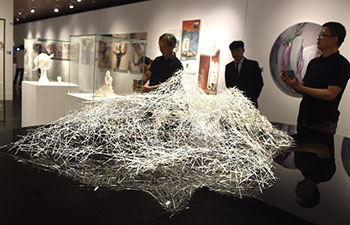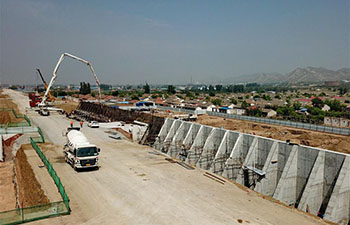WASHINGTON, June 13 (Xinhua) -- An international team of scientists has discovered that the world's ice shelves may be being destabilized by forces from above and below, according to a study published Wednesday in the journal Science Advances.
The researchers found that warm ocean water flowing in channels beneath Antarctic ice shelves was thinning the ice from below so much that the ice in the channels is cracking.
Then, surface meltwater could flow into these fractures, further destabilizing the ice shelf and increasing the chances that substantial pieces will break away.
Led by Christine Dow, a professor of Canada's University of Waterloo, the researchers described this mechanism in a major ice break up, or calving, event in 2016 at Antarctica's Nansen Ice Shelf.
The researchers, including those from U.S. University of Texas Institute for Geophysics (UTIG), also found fractures associated with channels underneath ice shelves in nearly every major outlet of Antarctic ice to the ocean as well as on Greenland's largest ice shelf in the Arctic.
Ice shelves, which are floating extensions of continental glaciers, slow down the flow of ice into the ocean and help control the rate of sea level rise.
As atmospheric temperatures are expected to rise in the coming decades and centuries, more surface meltwater will be available on fractured ice shelves, which could result in many more catastrophic ice loss events, according to the study.
"We're beginning to understand how the retreat of Antarctica's sensitive glaciers probably begins in a warming climate," said Donald Blankenship, a UTIG senior research scientist and co-author of the new study. "It's interesting and, of course, troubling that the impacts of ocean and atmosphere melting can combine to accelerate the loss of important ice shelves."
In the case of the calving event on the Nansen Ice Shelf, researchers discovered a spectacular river of surface meltwater pouring into a massive rift in the ice shelf in 2014.
Some in the scientific community thought the river could have a stabilizing effect on the ice shelf by removing water that might otherwise form into melt ponds. However, a different and more worrying story emerged when two large icebergs broke off at the fracture.
The research team used radar surveys and satellite imagery to link the calving event to the channels melted into the bottom of the ice shelf and the impact of the surface melt.
The research represents a collaboration between researchers from Canada, the United States and the Republic of Korea, using multiple datasets collected by both airborne and satellite platforms.

















